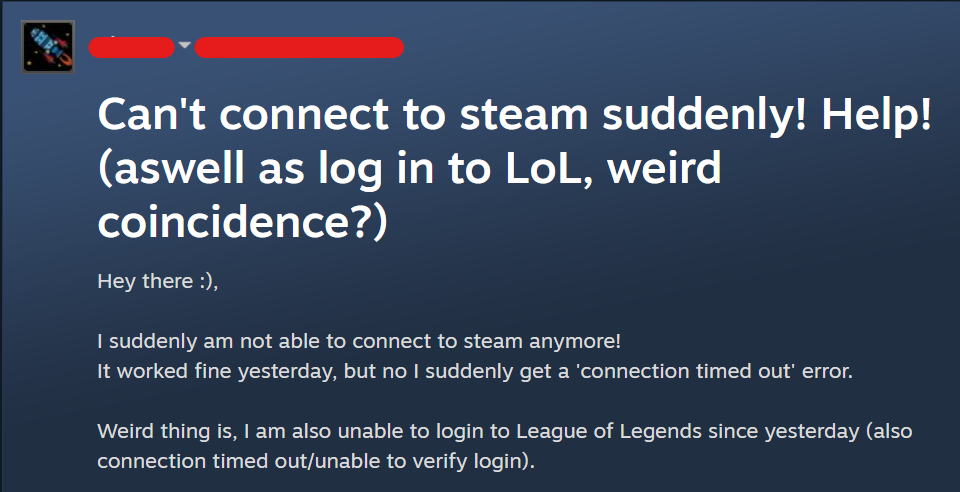Are you experiencing the frustrating “Connection timed out. Attempting to reconnect” error while trying to play League of Legends?
This issue can be a major hindrance to your gaming experience, but fear not!
In this blog, we will explore effective solutions to resolve the “Connection timed out” error in League of Legends.
How To Fix League Of Legends Connection Timed Out Attempting To Reconnect Error?

To fix League of Legends Connection timed out attempting to reconnect error, you can check RIOT Games server status, test your internet connection, and whitelist League Of Legends in firewall and antivirus. Additionally, you can reset your network adapter, clear your DNS cache, and change your DNS settings to fix the issue.
1. Check Riot Games Server Status

First and foremost, check the Riot Games Service Status for any announcements regarding server issues or maintenance that could be causing the error.
This will help you determine if the problem is on your end or with the game’s servers.
2. Test Your Internet Connection
Ensure your internet connection is stable and robust. An unstable or slow connection could be the root of the problem.
- Navigate to a speed test website such as Speedtest by Ookla.
- Click on the “Go” button to start the test.
- Wait for the test to complete and review your upload and download speeds against your ISP’s promised speeds.
3. Whitelist League Of Legends In Firewall And Antivirus
Add League of Legends to the exceptions list of your firewall and antivirus program.
This prevents these security programs from mistakenly blocking or limiting the game’s internet access.
For Windows Firewall:
- Open the Start Menu and type “Firewall,” then click on “Windows Defender Firewall.”
- On the left pane, click on “Allow an app or feature through Windows Defender Firewall.”
- Click “Change settings” (you may need administrator privileges).
- Click “Allow another app,” find the League of Legends executable, and add it to the list.
- Ensure both “Private” and “Public” boxes are checked for League of Legends and click “OK.”
For Antivirus Program:
- Open your antivirus software.
- Navigate to the settings or exceptions area (this varies by program).
- Add the League of Legends folder to your exceptions or exclusions list.
4. Reset Your Network Adapter
Reset your network adapter by disabling it and then re-enabling it through your computer’s network settings.
This can often resolve temporary connectivity issues.
For Windows:
- Press Windows Key + R, type ncpa.cpl into the Run dialog, and press Enter.
- Right-click your network adapter and select “Disable.”
- Wait a few moments, then right-click the adapter again and select “Enable.”
For macOS:
- Click the Apple menu and select “System Preferences.”
- Choose “Network,” select your active network interface, then click on the “Advanced” button.
- Go to the “TCP/IP” tab and click on “Renew DHCP Lease.”
5. Clear Your DNS Cache
Clearing your DNS cache can resolve connection issues caused by outdated or corrupted DNS records that may misdirect your requests to the game servers.
This process refreshes the DNS entries on your computer, potentially fixing the “Connection timed out; attempting to reconnect” error.
Here’s how you can do it on a Windows system:
For Windows:
- Press Windows Key + R to open the Run dialog box.
- Type cmd and press Enter to launch the Command Prompt.
- Type ipconfig /flushdns in the Command Prompt and press Enter.
- Look for a confirmation message indicating the DNS cache has been flushed.
For macOS:
- Open the Terminal application (found in Applications/Utilities or via Spotlight search).
- Type sudo dscacheutil -flushcache; sudo killall -HUP mDNSResponder and press Enter.
- Enter your administrator password when prompted and press Enter again.
- There will be no confirmation message in Terminal, but the DNS cache will be cleared.
6. Change Your DNS Settings
Switch to a public DNS server, such as Google’s 8.8.8.8 or 8.8.4.4, which can sometimes provide a more stable connection to the game servers.
For Windows:
- Press Windows Key + R, type ncpa.cpl, and press Enter to open Network Connections.
- Right-click on your active network adapter and select “Properties.”
- Scroll down to “Internet Protocol Version 4 (TCP/IPv4)” and click on “Properties.”
- Select “Use the following DNS server addresses:”
- Enter 8.8.8.8 as the Preferred DNS server.
- Enter 8.8.4.4 as the Alternate DNS server.
- Click “OK” to save your changes.
For macOS:
- Click the Apple menu and go to “System Preferences” > “Network.”
- Select your active network connection and click “Advanced.”
- Go to the “DNS” tab.
- Click the “+” button to add a new DNS server and enter 8.8.8.8.
- Click the “+” button again and add 8.8.4.4 as an alternate DNS server.
- Click “OK” and then “Apply” to save your changes.
7. Update Your Network Drivers
Ensure your network drivers are up to date.
Outdated drivers can cause a variety of connectivity issues, including time-outs.
- Press Windows Key + X and select “Device Manager.”
- Expand the “Network adapters” section.
- Right-click on your network adapter and select “Update driver.”
- Choose “Search automatically for updated driver software.”
- Follow the prompts to install any available updates.
- Restart your computer if prompted.
8. Disable Peer-to-Peer Updates
League of Legends may use peer-to-peer (P2P) updates by default.
Disabling this feature can sometimes improve your connection.
You can find this setting in the client’s options.
- Open the League of Legends client and log in.
- Click on the gear icon (settings) in the top right corner of the client.
- Navigate to the “General” tab within the settings menu.
- Scroll down to find the “Peer-to-Peer Transfer” option.
- Uncheck the box next to “Enable Peer-to-Peer Transfer.”
- Save your changes and close the settings menu.
9. Use A VPN
Sometimes, your network’s route to the game servers may be congested or have some interference, leading to timeouts.
Using a VPN can help you establish a more stable connection by routing your traffic through a different path.
- Select a reputable VPN provider with servers near the League of Legends servers.
- Download and install the VPN client from the provider’s website.
- Log into the VPN client and connect to a server close to the game server.
- Open League of Legends and attempt to connect to the game.
10. Contact League Of Legends Support

If you’ve tried all the above solutions and still face the “Connection timed out; attempting to reconnect” error, reach out to League of Legends Customer Support.
Provide them with details of the steps you’ve already taken and any error messages you’ve received to help them diagnose and resolve the issue more efficiently.

